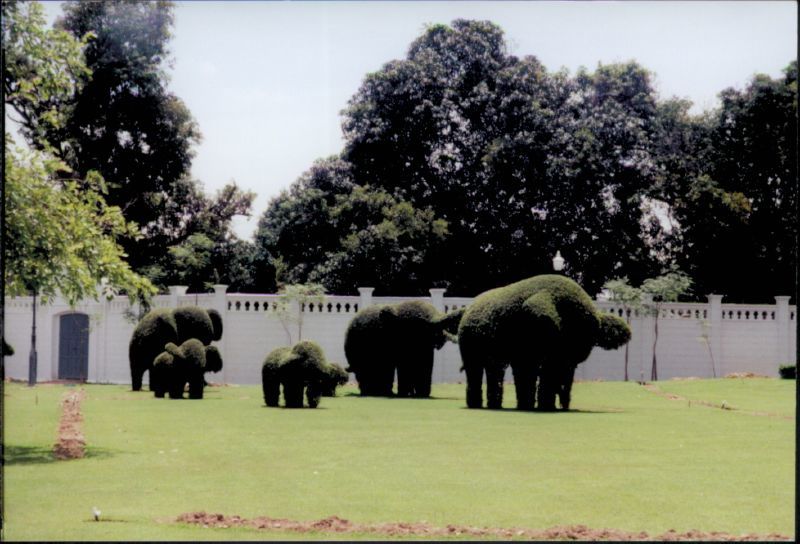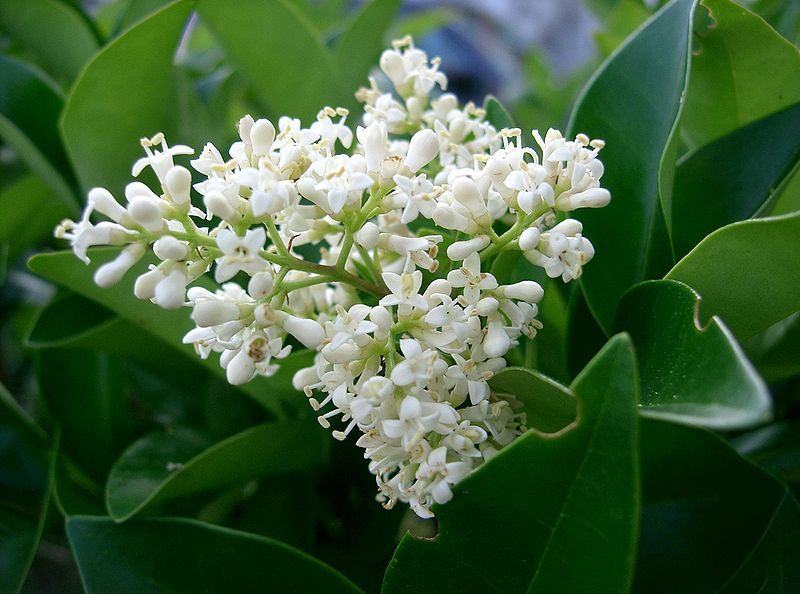Topiary garden elements
. . . are a living art form that dates back to Roman times. Always unique, they add a formal air to gardens everywhere from the European elite to the simple cottage garden.
Topiary is the art of clipping and shaping shrubs and trees.
They can be pruned and/or trained into geometric shapes like balls, cubes, obelisks, pyramids, cones, spirals, or random shapes of objects or things like a map, an airplane or even an animal.
Topiary creations are best formed with evergreen shrubs that are vigorous, cold hardy, and small to medium sized leaves.

photo courtesy of flickr:
https://www.flickr.com/photos/amanderson/533823361/in/photostream/
Suggestions For Topiary Creations For Zone 9
Here's a few suggestions to get your creative juices going:

© Copyright Brian Chadwick and licensed for reuse under this Creative Commons Licence
Japanese boxwood (Buxus Microphylla Japonica):
This is a slow growing plant that reaches 3-12' tall, depending on the variety. It has small, glossy, evergreen leaves with inconspicuous, creamy white flowers in the spring. The slower rate of growth makes it easier to maintain once your topiary is formed. Hardy in zones 6-9.
The shallow root system of boxwood is easily damaged by digging nearby, so don't plant other things too close. They love good drainage, and love a good layer of mulch about 2" deep to help maintain consistent soil moisture and temperature. Does well in full sun to partial shade.
Ligustrum (Ligustrum Japonicum): aka 'waxleaf ligustrum'
Ligustrum is a fast growing evergreen with a medium sized leaf that yields quick, easy results but will require more frequent maintenance pruning. It is a favorite for creating topiaries because of its rapid growth rate. Ligustrum Sinensis Variegata is a varigated leaf variety with a lot of yellow tones. Hardy in zones 8-10, ligustrum loves full sun to part shade. Extremely tolerant of a wide variety of soil conditions.
Also known as "Japanese Privet", this is a species of ligustrum native to southern Japan & Korea. It is usually seen at about 6-12' high, but can reach up to 20' hgt. They have large 5-8" clusters of white flowers in the spring, followed by green berries that ripen to dull black in the winter. If using as a solid privacy hedge, space plants about 5' apart.

photo courtesy of wikipedia:
http://commons.wikimedia.org/wiki/File:Ligustrum_japonicum_04.jpg

Walters Viburnum (Viburnum obovatum):
This is another fast growing evergreen (in Florida) for quick results with a smaller leaf than the ligustrum. It is a native to North & Central Florida, zones 8-9. It is usually found in slightly acidic moist woods, near streams or in swamps.
Young twigs have a reddish fuzz that is quite pretty. The leaves are only about 1-2" long. Total height can be as much as 30', but is more commonly 6-15'. It attracts butterflies in the spring and being a very dense plant, is a favorite nesting spot for cardinals and other song birds.
Walter's viburnum blooms more profusely in full sun, but tolerates part shade very nicely. Needs frequent watering the first year. It has tiny, creamy white flowers arranged in bunches 2-3" in across. "Mrs. Schiller's Delight" is a very popular dwarf variety that is particularly suited to formal hedging.
General prices & sizes at the time of this post -- subject to availability:
Boxwood:
1gal -- 10-12"x8" -- $6
3gal -- 12"x12" -- $13.50
Ligustrum:
3gal -- 20-24"x16" -- $13.50
7gal -- 36"x25" --- $45
Viburnum:
3gal -- 14-16"x12" -- $15
7gal -- 30"x32" -- $45
Be Inspired !

Photo credits: By Dincher (Own work) [CC BY-SA 3.0 (http://creativecommons.org/licenses/by-sa/3.0)], via Wikimedia Commons
Photo at left:
The Entrance to Pearl Fryar's topiary garden in Bishopville, South Carolina
Pearl Fryer is a topiary artist living in South Carolina who creates fantastic topiary art for his garden.
Now internationally recognized and the subject of many magazine & newspaper articles, and even a television documentary, "A Man Named Pearl", Pearl Fryer creates many of his masterpieces from plants thrown away at the compost pile at local nurseries.
